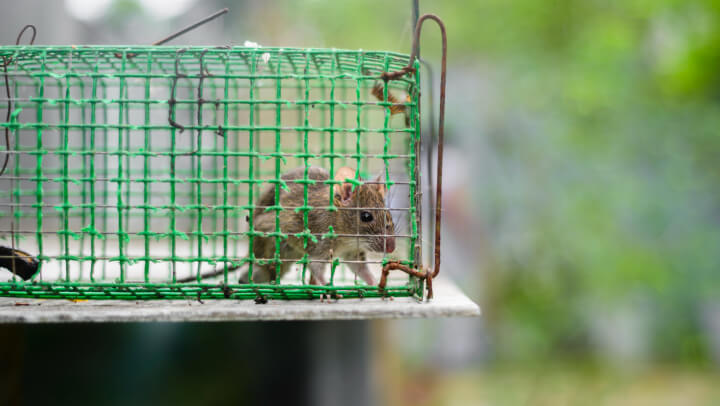


Any homeowner is potentially at risk for having a rat or mouse infestation. Fortunately, it’s easy to manage rodents by putting down mouse traps to catch and remove them from the property. However, mice and rats are smart and if you don’t use the right strategy in setting up traps around the home, you may end up being unsuccessful with your rodent control attempt.
So is there a right way to install mouse traps indoors? Yes, the best way to place mouse traps is to put them perpendicular to the wall surface. Rats and mice love to stick close to walls and baseboards when running around so you have higher chances of catching them when you properly place the traps along their runways.
Learn More: How Often Should You Change Mice Trap Bait?
Mice are nocturnal critters so you’ve most likely spotted them wandering near the kitchen or pantry at night. Think back to those encounters and you may have noticed that these rodents never stray away from the walls or corners of the room. The reason for that is most mice and rats have weak vision.
They’re far-sighted and have difficulty seeing their surroundings and objects very clearly. To compensate for their poor eyesight, mice use their whiskers to explore and detect any threats or movement nearby. Whenever rodents come out of their nests at night, they like to keep their whiskers close to the wall to help them find their way around your home.
So when you’re planning to put up mouse traps to capture mice, it’s best to position them close or perpendicular to the walls. You won’t have any success in trapping rodents if you put them in the middle of the room since rats and mice tend to avoid open spaces.
Placing the mouse traps perpendicularly provides two sides where the rodents can run through your trap. It should be set close to the wall so that the mice won’t be able to easily escape or jump over the trap. It’s also ideal to place multiple traps next to each other so if any rodent decides to leap over, they can still get caught in the other trap.
One advantage of mouse traps is that they’re completely non-toxic. They’re a good alternative for rodent control when rodenticides and poison bait stations are not an option. They’realso fuss-free and easy-to-use so you can install them on your own inside your home. Here are some reminders on how to correctly handle and place mouse traps:
The most important step in mouse trapping is to locate the path that the mice are often using. You can search for evidence of mouse activity like rodent droppings, urine trails, or grease marks to determine where your unwelcome visitors could be walking along. You can also check cluttered areas and dusty rooms and look for footprint marks to confirm their presence in your home.
When you visit your local hardware store, you can find different types of traps for rodent control. These mouse trap devices have their own specific features and have different ways of getting rid of mice. Here’s an overview of the most common types of mouse traps:
| Best Used For | How It Works | |
| Snap traps | Snap traps are the least expensive choice for reducing indoor rodent population and it can instantly kill any rodents that come into contact with the trap. | Installing a traditional snap trap is the most classic way of doing rodent control. It comes with either a wooden or metal surface and a spring-loaded bar that will release once the rodents trigger the mechanism. |
| Electronic traps | An electric trap is another device that can immediately get rid of mice. Its main difference from a snap trap is that it kills the rodent inside a closed chamber or box. | Most electronic mouse traps are battery-powered and it releases a quick charge of electric shock to instantly eliminate the mice. It’s easier to clean up and there’s little risk of contamination because the dead rodent is kept inside the trap. |
| Live traps | They’re the best choice for humane traps because it allows you to capture rodents without harming them. | Live mouse traps utilize a catch-and-release system where you place a bait and wait for them to enter the box. After they’re trapped, you can simply take the box outside and release them in the wild. It’s best if you bring the captured mice away from your home so they won’t be able to return. |
| Glue traps | Glue boards work best for controlling smaller infestations and preventing mice from doing further damage in your home. | Glue traps or sticky traps are made of a flat piece of cardboard and they’re covered with a strong adhesive to immobilize mice upon contact. |
Selecting the right food attractant is the key to an effective trap. Although it's a popular belief that cheese is the best house mouse bait, they can easily steal the block of cheddar while avoiding the trap. Peanut butter is a top bait choice for mouse trapping since they’re sticky and mice will have a hard time taking it off the trap. You can also use nuts, fruits seeds, grains, chocolate, and nesting material, but make sure to secure them with dental floss.
Mousetrapping requires a lot of patience since most rodents may initially be cautious once they detect a new object along their path. It’s recommended to regularly check your traps at least 2 to 3 times a week to see if any mouse has been caught. You also need to make sure that your bait remains fresh to attract the mice so you should replace it with new ones when they become stale.
When removing the mousetrap, don’t forget to wear disposable rubber gloves before picking it up. Mice can urinate or release droppings in the area due to the shock of being trapped so you should have protection to avoid direct contamination. Spray a disinfectant over the mice before putting them in a sealed plastic bag and placing them in the trash can. Afterward, you should clean and sanitize the surfaces and nearby spots where the trap was placed.
Read More: How Far Should You Space Mouse Traps Apart?

There are cases where you may have experienced not catching any rodents despite placing a dozen traps around your home. Here are some common mistakes that may be affecting your success with mouse trapping:
It’s crucial to install mouse traps closely against the wall or perpendicular to its base to ensure that mice can easily encounter them. If you place them parallel to the wall, there’s a possibility that the mouse can accidentally set off the other end of the trap while evading the capture. When positioning snap traps, the trigger part of the trap should be against the wall to release the metal bar upon contact.
Mice are typically active along walls, crawl spaces, attics, basement, and the kitchen so make sure to place your traps in these areas. As much as possible, the traps should be set along rodent runways so they’ll easily discover them when they are scavenging for a food source. They also like to come out in warm and dark spaces so you may not have success in trapping in well-lit and open areas.
You always have to wear gloves before touching any bait or mouse trap. With their sensitive sense of smell, mice can catch your scent which can alert them to stay away from the trap. Wearing gloves is also a way to protect yourself from germs, bacteria, and viruses that the mice may have released in the area.
Although rodents are a common pest problem for homeowners, there are ways you can make your property less inviting for them. Here are some of the measures to ensure your home stays rodent-free:
Learn More: Are There Any Humane Mouse Trap Substitutes?

It’s best to skip DIY rodent control especially when you already have a severe mouse infestation. For extreme cases of pest infestations, call the experts at Permakill Exterminating to go beyond setting up mouse traps at home and make sure that your rodent problem doesn’t come back.
Permakill Exterminating provides a comprehensive pest control service to eliminate not just rodents but also other insects, bed bugs, and termites. We pride ourselves in offering quality pest management solutions and treatments to address your needs. Call us now to learn more about our home protection plans and services.